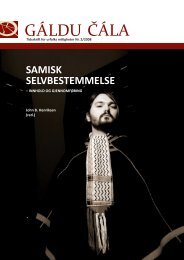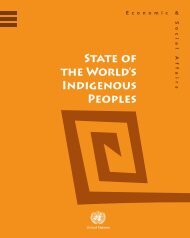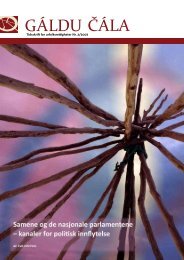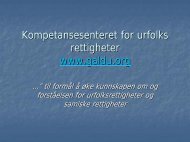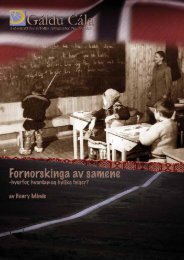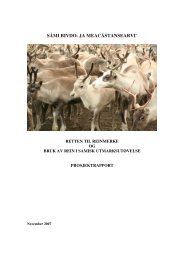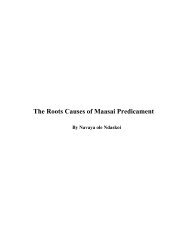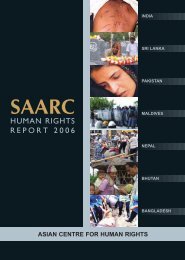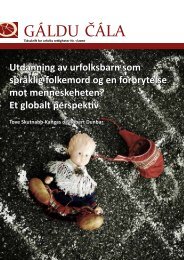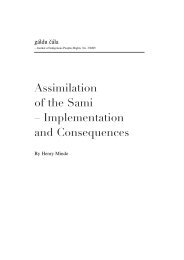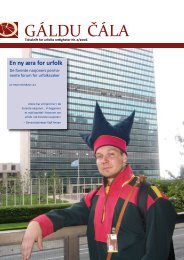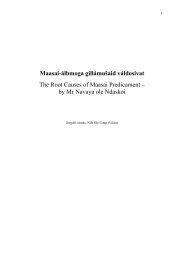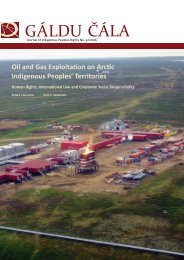Menneskerettigheter, selvbestemmelsesretten og andre sentrale ...
Menneskerettigheter, selvbestemmelsesretten og andre sentrale ...
Menneskerettigheter, selvbestemmelsesretten og andre sentrale ...
You also want an ePaper? Increase the reach of your titles
YUMPU automatically turns print PDFs into web optimized ePapers that Google loves.
GÁLDU ČÁLA 3/2007”Indigenous peoples have the right to ...be secure in the enjoyment of their ownmeans of subsistence and development,and to engage freely in all their traditionaland other economic activities. Indigenouspeoples who have been deprived of theirmeans of subsistence and development areentitled to just and fair compensation.”Se också artikel 31, citerad ovan, som angeratt ”land and resource management” ingår iurfolkens självbestämmanderätt.Det förefaller även som att FN:s medlemsländeridag är beredda att accepteraen självbestämmanderätt som innefattar ensådan resursdimension. Det nordiska förslagettill WGDD, beskrivet ovan, innehöll,i tillägg till vad där anförts, även vissa förändringari Urfolksdeklarationens artikel30, som i dess nuvarande form lyder;“Indigenous peoples have the right todetermine and develop priorities andstrategies for the development or use oftheir lands, territories and other resources,including the right to require that Statesobtain their free and informed consentprior to the approval of any project affectingtheir lands, territories and otherresources, particularly in connection withthe development, utilization or exploitationof mineral, water or other resources.Pursuant to agreement with the indigenouspeoples concerned, just and faircompensation shall be provided for anysuch activities and measures taken tomitigate adverse environmental, economic,social, cultural or spiritual impact.”Enligt det nordiska förslaget flyttas den understruknatexten till den del av Urfolksdeklarationensom särskilt behandlar rätten tillsjälvbestämmande, medan den därefteråterstående texten skall inkorporeras i deartiklar i Urfolksdeklarationen som behandlarlandrättigheter. 121 Den övervägande majoritetenstater som deltar i WGDD stöttadedet nordiska förslaget också i denna del.Inom resursdimensionen av självbestämmanderättenmåste även beaktas genetiskaresurser, traditionell kunskap och traditionellakulturella uttryck (TCEs). Somanförts ovan ingår som ett centralt elementi självbestämmanderätten alla folks rätt attbestämma över sin kulturella utveckling.Principles and Guidelines for the Protectionof the Heritage of Indigenous Peoplesanför att;“To be effective, the protection of indigenouspeoples’ heritage should be basedbroadly on the principle of self-determination,which includes the right of indigenouspeoples to maintain and develop their owncultures and knowledge systems” 122Närliggande till rätten att kontrollera sinkulturella utveckling är folkens rätt attbestämma över sitt kreativa skapande. Härkan även exempelvis hänvisas till CESCRArtikel 15 som understryker att;”... the right of everyone ... to benefit fromthe protection of the moral and materialinterests resulting from any scientific,literary or artistic production of which heis the author.” 123CESCR Artikel 15 är formulerad som enindividuell rättighet – den syftar enligtordalydelsen till att skydda individuella upphovsmänsskapande. Rätt till traditionellkunskap och TCEs utgör emellertid - perdefinition - en kollektiv rättighet. Traditionellkunskap och TCEs uppstår som ettresultat av att ett folk, som ett kollektiv,responderar till förändringar i sin levnadsmiljö,i enlighet med deras specifika traditioner.Det är därför normalt inte möjligtatt identifiera en enskild, eller grupp, avskapare bakom traditionell kunskap eller121 Det förslag som behandlar markrätigheterna behandlas inte vidare i denna framställning.122 OP 2123 Se även WIPO Dokument WIPO/GRTKF/IC/4/8, paragraph 28 som anför att “Because its generation, preservation and transmission is based on cultural traditions,traditional knowledge is essentially culturally-oriented or culturally-rooted, and it is integral to the culture identity of the social group in which it operates and is preserved.From the point of view of culture of the community in which it has originated, every component of traditional knowledge can help define that community’s own identity.”och vidare WIPO Dokument WIPO/GRTKF/IC/3/8, paragraph 14 vilket anger att “By contrast, the cultural identity dimension of traditional knowledge may have a dramaticimpact on any future legal framework for its protection, because, being a means of cultural identification, the protection of traditional knowledge … ceases to be simply amatter of economics or of exclusive rights over technol<strong>og</strong>y as such. It acquires a human rights dimension indeed”.87



